【深入理解反向传播BP】Calculus on Computational Graphs: Backpropagation
2017-06-14 11:01
525 查看
大牛的博客,只能膜拜:
http://colah.github.io/posts/2015-08-Backprop/
反向传播不仅仅是链式法则那么简单。。。
从naive的“sum derivations of all paths” ==》到“factoring paths”==》再到“forward-mode differentiation”(对每个计算节点进行∂∂input)==》最后是“Reverse-mode
differentiation”==》forward-mode和reverse-mode的区别和联系,以及思考
∂∂input
Backpropagation is the key algorithm that makes training deep models computationally tractable. For modern neural networks, it can make training with gradient descent as much as ten million times faster, relative to a naive implementation. That’s the difference
between a model taking a week to train and taking 200,000 years.
Beyond its use in deep learning, backpropagation is a powerful computational tool in many other areas, ranging from weather forecasting to analyzing numerical stability – it just goes by different names. In fact, the algorithm has been reinvented at least dozens
of times in different fields (see Griewank (2010)). The general, application independent,
name is “reverse-mode differentiation.”
Fundamentally, it’s a technique for calculating derivatives quickly. And it’s an essential trick to have in your bag, not only in deep learning, but in a wide variety of numerical computing situations.
Computational graphs are a nice way to think about mathematical expressions. For example, consider the expression e=(a+b)∗(b+1)e=(a+b)∗(b+1).
There are three operations: two additions and one multiplication. To help us talk about this, let’s introduce two intermediary variables, ccand dd so
that every function’s output has a variable. We now have:
c=a+bc=a+b
d=b+1d=b+1
e=c∗de=c∗d
To create a computational graph, we make each of these operations, along with the input variables, into nodes. When one node’s value is the input to another node, an arrow goes from one to another.

These sorts of graphs come up all the time in computer science, especially in talking about functional programs. They are very closely related to the notions of dependency graphs and call graphs. They’re also the core abstraction behind the popular deep learning
framework Theano.
We can evaluate the expression by setting the input variables to certain values and computing nodes up through the graph. For example, let’s set a=2a=2 and b=1b=1:

The expression evaluates to 66.
If one wants to understand derivatives in a computational graph, the key is to understand derivatives on the edges. If aa directly
affects cc,
then we want to know how it affects cc.
If aachanges
a little bit, how does cc change?
We call this the partial derivative of cc with
respect to aa.
To evaluate the partial derivatives in this graph, we need the sum rule and the product
rule:
∂∂a(a+b)=∂a∂a+∂b∂a=1∂∂a(a+b)=∂a∂a+∂b∂a=1
∂∂uuv=u∂v∂u+v∂u∂u=v∂∂uuv=u∂v∂u+v∂u∂u=v
Below, the graph has the derivative on each edge labeled.
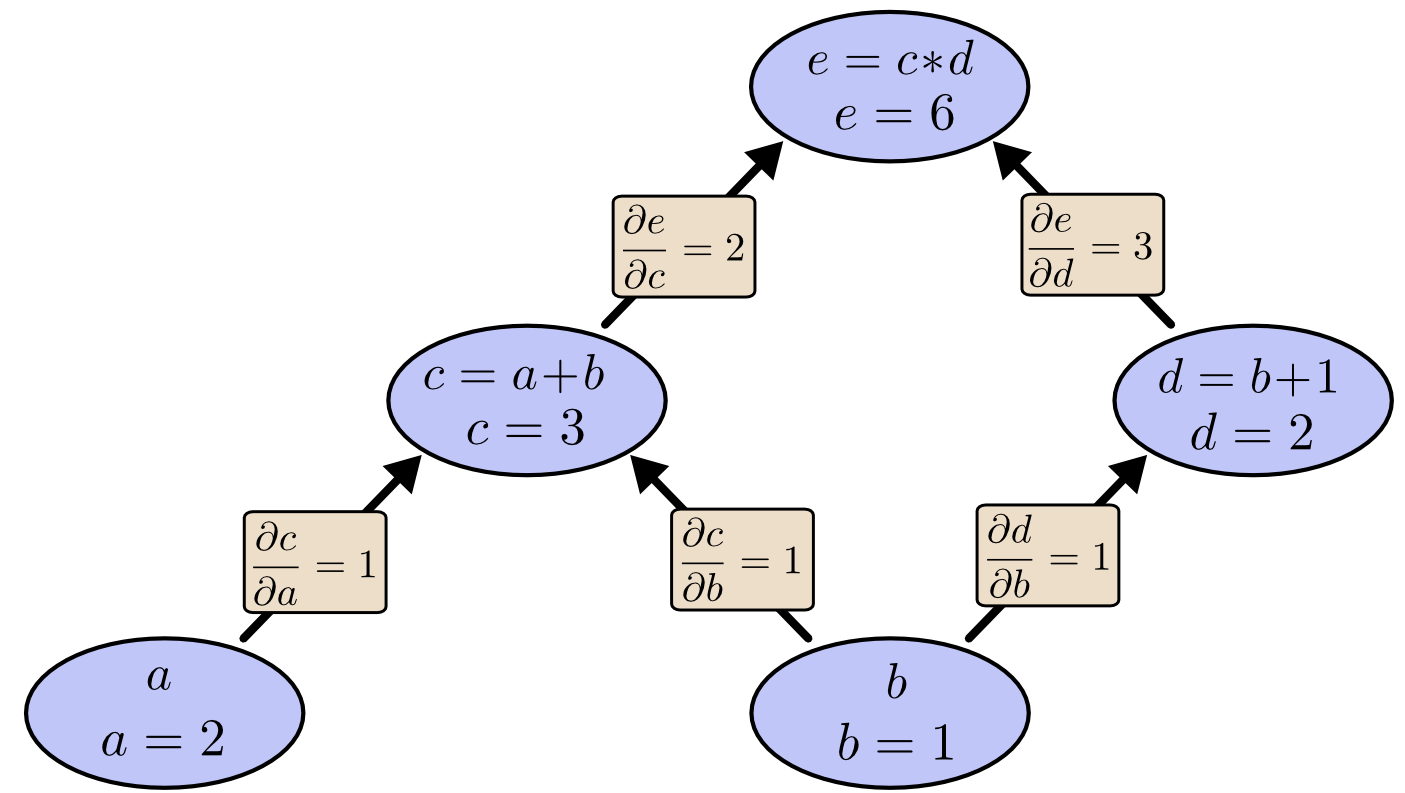
What if we want to understand how nodes that aren’t directly connected affect each other? Let’s consider how ee is
affected by aa.
If we change aa at
a speed of 1, cc also
changes at a speed of 11.
In turn, cc changing
at a speed of 11 causes ee to
change at a speed of 22.
So eechanges
at a rate of 1∗21∗2 with
respect to aa.
The general rule is to sum over all possible paths from one node to the other, multiplying the derivatives on each edge of the path together. For example, to get the derivative of ee with
respect to bb we
get:
∂e∂b=1∗2+1∗3∂e∂b=1∗2+1∗3
This accounts for how b affects e through c and also how it affects it through d.
This general “sum over paths” rule is just a different way of thinking about the multivariate chain rule.
The problem with just “summing over the paths” is that it’s very easy to get a combinatorial explosion in the number of possible paths.

In the above diagram, there are three paths from XX to YY,
and a further three paths from YYto ZZ.
If we want to get the derivative ∂Z∂X∂Z∂X by
summing over all paths, we need to sum over 3∗3=93∗3=9 paths:
∂Z∂X=αδ+αϵ+αζ+βδ+βϵ+βζ+γδ+γϵ+γζ∂Z∂X=αδ+αϵ+αζ+βδ+βϵ+βζ+γδ+γϵ+γζ
The above only has nine paths, but it would be easy to have the number of paths to grow exponentially as the graph becomes more complicated.
Instead of just naively summing over the paths, it would be much better to factor them:
∂Z∂X=(α+β+γ)(δ+ϵ+ζ)∂Z∂X=(α+β+γ)(δ+ϵ+ζ)
This is where “forward-mode differentiation” and “reverse-mode differentiation” come in. They’re algorithms for efficiently computing the sum by factoring the paths. Instead of summing over all of the paths explicitly, they compute the same sum more efficiently
by merging paths back together at every node. In fact, both algorithms touch each edge exactly once!
Forward-mode differentiation starts at an input to the graph and moves towards the end. At every node, it sums all the paths feeding in. Each of those paths represents one way in which the input affects that node. By adding them up, we get the total way in
which the node is affected by the input, it’s derivative.
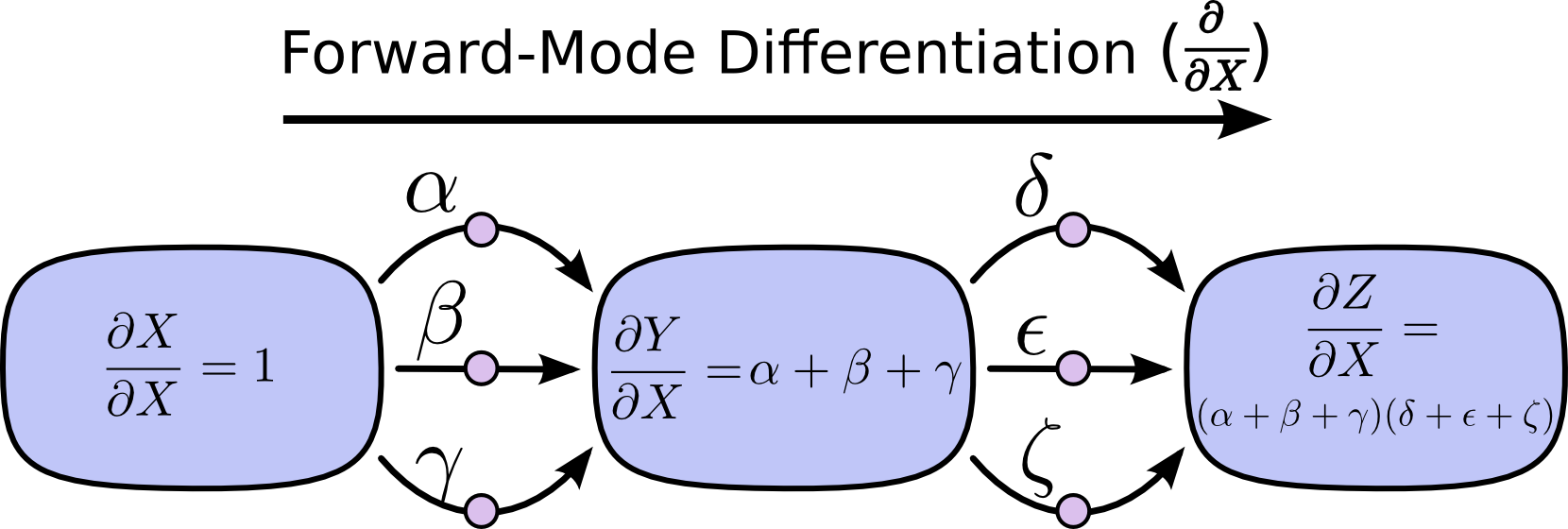
Though you probably didn’t think of it in terms of graphs, forward-mode differentiation is very similar to what you implicitly learned to do if you took an introduction to calculus class.
Reverse-mode differentiation, on the other hand, starts at an output of the graph and moves towards the beginning. At each node, it merges all paths which originated at that node.
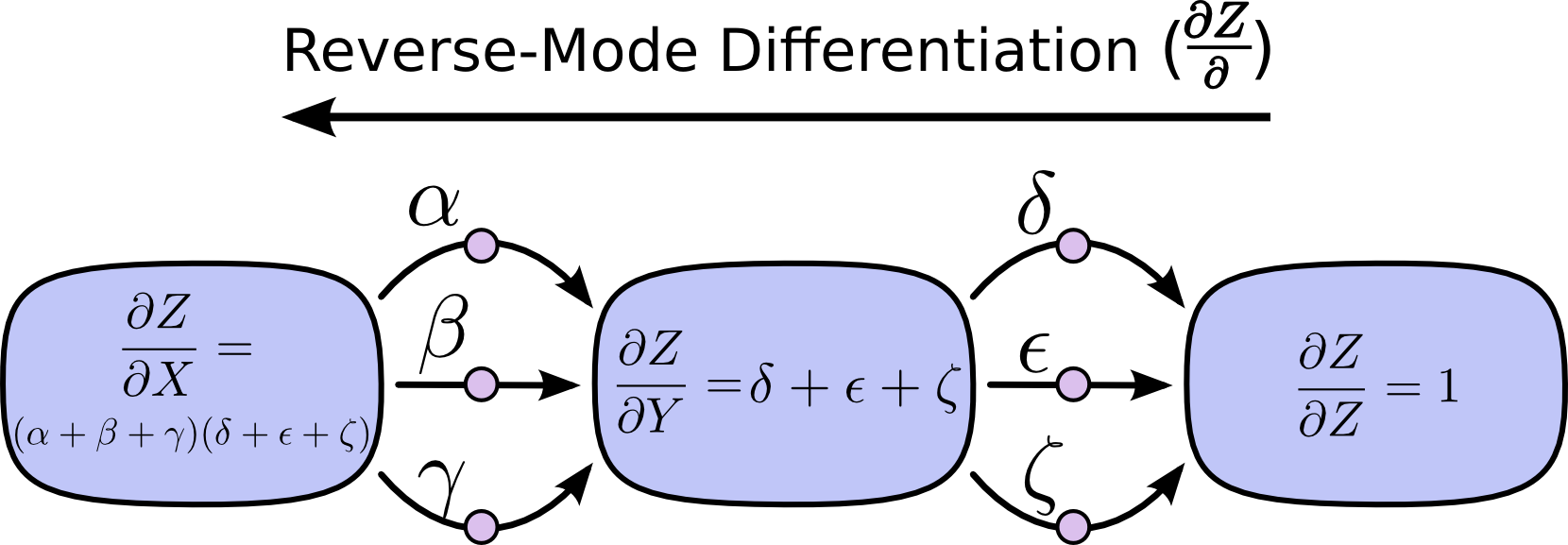
Forward-mode differentiation tracks how one input affects every node. Reverse-mode differentiation tracks how every node affects one output. That is, forward-mode differentiation applies the operator ∂∂X∂X to
every node, while reverse mode differentiation applies the operator ∂Z∂ to
every node.1
At this point, you might wonder why anyone would care about reverse-mode differentiation. It looks like a strange way of doing the same thing as the forward-mode. Is there some advantage?
Let’s consider our original example again:

We can use forward-mode differentiation from bb up.
This gives us the derivative of every node with respect to bb.
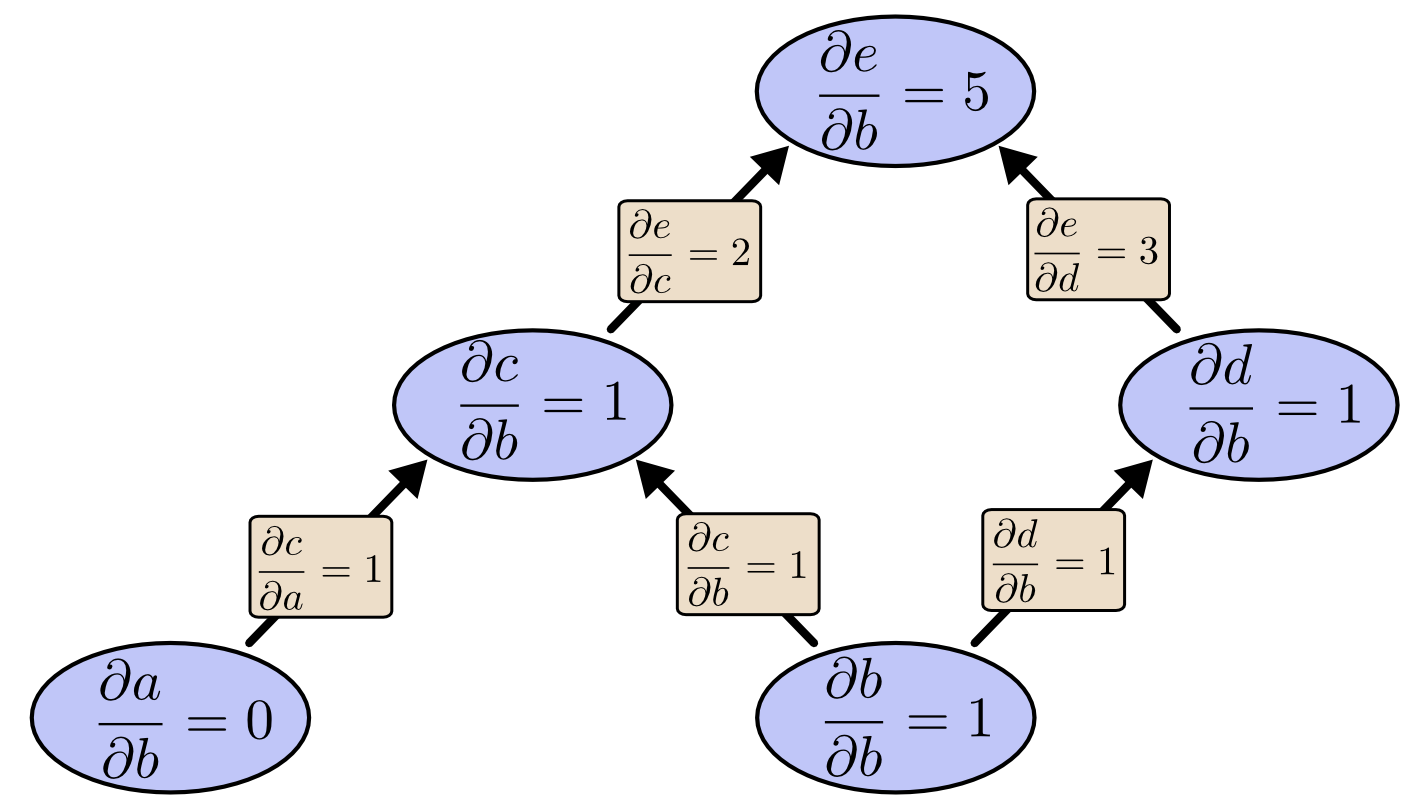
We’ve computed ∂e∂b∂e∂b,
the derivative of our output with respect to one of our inputs.
What if we do reverse-mode differentiation from ee down?
This gives us the derivative of eewith
respect to every node:
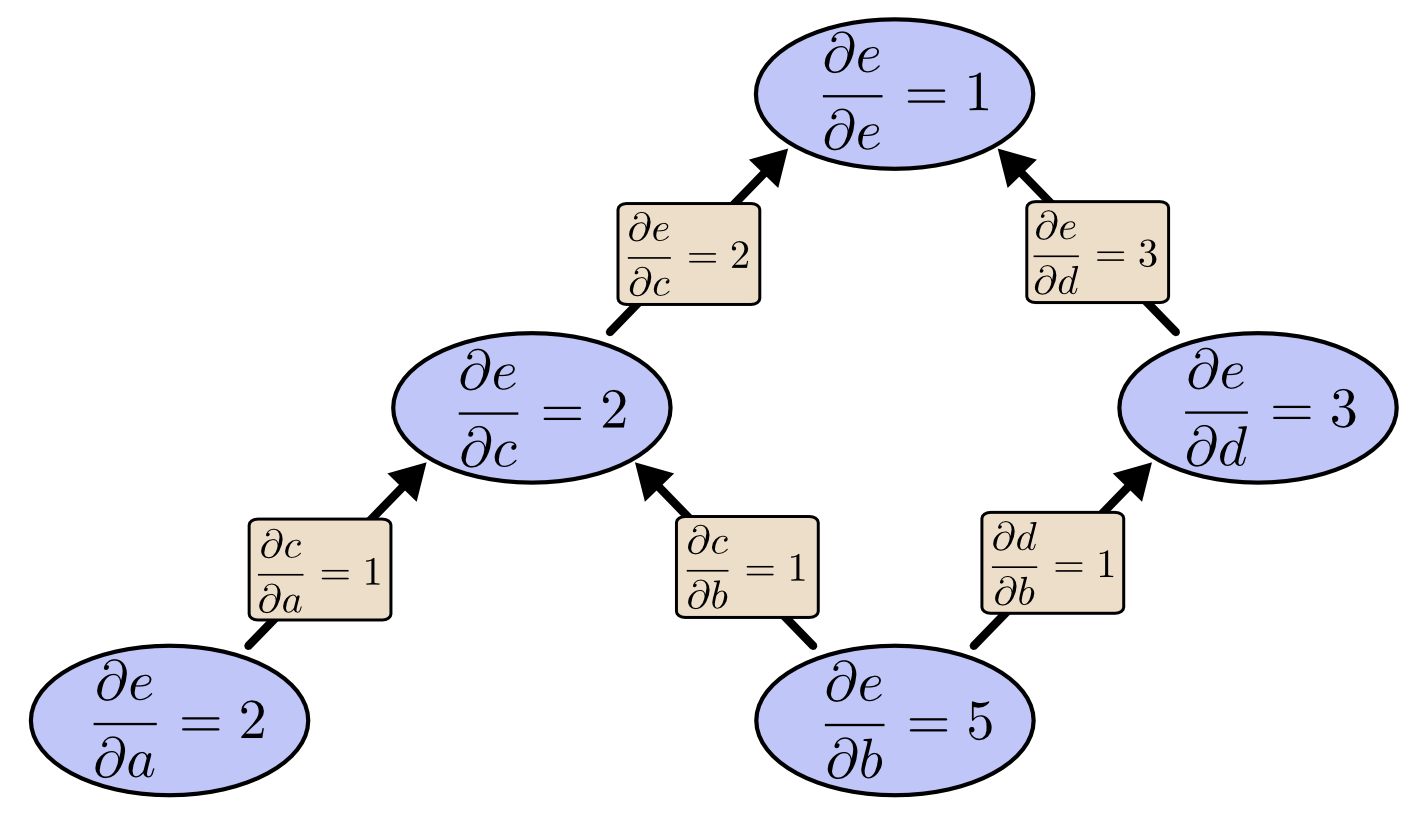
When I say that reverse-mode differentiation gives us the derivative of e with respect to every node, I really do mean every node. We get both ∂e∂a∂e∂a and ∂e∂b∂e∂b,
the derivatives of ee with
respect to both inputs. Forward-mode differentiation gave us the derivative of our output with respect to a single input, but reverse-mode differentiation gives us all of them.
For this graph, that’s only a factor of two speed up, but imagine a function with a million inputs and one output. Forward-mode differentiation would require us to go through the graph a million times to get the derivatives. Reverse-mode differentiation can
get them all in one fell swoop! A speed up of a factor of a million is pretty nice!
When training neural networks, we think of the cost (a value describing how bad a neural network performs) as a function of the parameters (numbers describing how the network behaves). We want to calculate the derivatives of the cost with respect to all the
parameters, for use in gradient descent. Now, there’s often millions, or even tens of millions of parameters in
a neural network. So, reverse-mode differentiation, called backpropagation in the context of neural networks, gives us a massive speed up!
(Are there any cases where forward-mode differentiation makes more sense? Yes, there are! Where the reverse-mode gives the derivatives of one output with respect to all inputs, the forward-mode gives us the derivatives of all outputs with respect to one input.
If one has a function with lots of outputs, forward-mode differentiation can be much, much, much faster.)
When I first understood what backpropagation was, my reaction was: “Oh, that’s just the chain rule! How did it take us so long to figure out?” I’m not the only one who’s had that reaction.It’s
true that if you ask “is there a smart way to calculate derivatives in feedforward neural networks?” the answer isn’t that difficult.
But I think it was much more difficult than it might seem. You see, at the time backpropagation was invented, people weren’t very focused on the feedforward neural networks that we study. It also wasn’t obvious that derivatives were the right way to train them.
Those are only obvious once you realize you can quickly calculate derivatives. There was a circular dependency.
Worse, it would be very easy to write off any piece of the circular dependency as impossible on casual thought. Training neural networks with derivatives? Surely you’d just get stuck in local minima. And obviously it would be expensive to compute all those
derivatives. It’s only because we know this approach works that we don’t immediately start listing reasons it’s likely not to.
That’s the benefit of hindsight. Once you’ve framed the question, the hardest work is already done.
Derivatives are cheaper than you think. That’s the main lesson to take away from this post. In fact, they’re unintuitively cheap, and us silly humans have had to repeatedly rediscover this fact. That’s an important thing to understand in deep learning. It’s
also a really useful thing to know in other fields, and only more so if it isn’t common knowledge.
Are there other lessons? I think there are.
Backpropagation is also a useful lens for understanding how derivatives flow through a model. This can be extremely helpful in reasoning about why some models are difficult to optimize. The classic example of this is the problem of vanishing gradients in recurrent
neural networks.
Finally, I claim there is a broad algorithmic lesson to take away from these techniques. Backpropagation and forward-mode differentiation use a powerful pair of tricks (linearization and dynamic programming) to compute derivatives more efficiently than one
might think possible. If you really understand these techniques, you can use them to efficiently calculate several other interesting expressions involving derivatives. We’ll explore this in a later blog post.
This post gives a very abstract treatment of backpropagation. I strongly recommend reading Michael Nielsen’s chapter
on it for an excellent discussion, more concretely focused on neural networks.
Thank you to Greg Corrado, Jon
Shlens, Samy Bengio and Anelia
Angelova for taking the time to proofread this post.
Thanks also to Dario Amodei, Michael
Nielsen and Yoshua Bengio for discussion of approaches to explaining backpropagation. Also thanks
to all those who tolerated me practicing explaining backpropagation in talks and seminar series!
This might feel a bit like dynamic programming. That’s because it
is!↩
http://colah.github.io/posts/2015-08-Backprop/
反向传播不仅仅是链式法则那么简单。。。
从naive的“sum derivations of all paths” ==》到“factoring paths”==》再到“forward-mode differentiation”(对每个计算节点进行∂∂input)==》最后是“Reverse-mode
differentiation”==》forward-mode和reverse-mode的区别和联系,以及思考
∂∂input
Introduction
Backpropagation is the key algorithm that makes training deep models computationally tractable. For modern neural networks, it can make training with gradient descent as much as ten million times faster, relative to a naive implementation. That’s the differencebetween a model taking a week to train and taking 200,000 years.
Beyond its use in deep learning, backpropagation is a powerful computational tool in many other areas, ranging from weather forecasting to analyzing numerical stability – it just goes by different names. In fact, the algorithm has been reinvented at least dozens
of times in different fields (see Griewank (2010)). The general, application independent,
name is “reverse-mode differentiation.”
Fundamentally, it’s a technique for calculating derivatives quickly. And it’s an essential trick to have in your bag, not only in deep learning, but in a wide variety of numerical computing situations.
Computational Graphs
Computational graphs are a nice way to think about mathematical expressions. For example, consider the expression e=(a+b)∗(b+1)e=(a+b)∗(b+1).There are three operations: two additions and one multiplication. To help us talk about this, let’s introduce two intermediary variables, ccand dd so
that every function’s output has a variable. We now have:
c=a+bc=a+b
d=b+1d=b+1
e=c∗de=c∗d
To create a computational graph, we make each of these operations, along with the input variables, into nodes. When one node’s value is the input to another node, an arrow goes from one to another.

These sorts of graphs come up all the time in computer science, especially in talking about functional programs. They are very closely related to the notions of dependency graphs and call graphs. They’re also the core abstraction behind the popular deep learning
framework Theano.
We can evaluate the expression by setting the input variables to certain values and computing nodes up through the graph. For example, let’s set a=2a=2 and b=1b=1:

The expression evaluates to 66.
Derivatives on Computational Graphs
If one wants to understand derivatives in a computational graph, the key is to understand derivatives on the edges. If aa directlyaffects cc,
then we want to know how it affects cc.
If aachanges
a little bit, how does cc change?
We call this the partial derivative of cc with
respect to aa.
To evaluate the partial derivatives in this graph, we need the sum rule and the product
rule:
∂∂a(a+b)=∂a∂a+∂b∂a=1∂∂a(a+b)=∂a∂a+∂b∂a=1
∂∂uuv=u∂v∂u+v∂u∂u=v∂∂uuv=u∂v∂u+v∂u∂u=v
Below, the graph has the derivative on each edge labeled.

What if we want to understand how nodes that aren’t directly connected affect each other? Let’s consider how ee is
affected by aa.
If we change aa at
a speed of 1, cc also
changes at a speed of 11.
In turn, cc changing
at a speed of 11 causes ee to
change at a speed of 22.
So eechanges
at a rate of 1∗21∗2 with
respect to aa.
The general rule is to sum over all possible paths from one node to the other, multiplying the derivatives on each edge of the path together. For example, to get the derivative of ee with
respect to bb we
get:
∂e∂b=1∗2+1∗3∂e∂b=1∗2+1∗3
This accounts for how b affects e through c and also how it affects it through d.
This general “sum over paths” rule is just a different way of thinking about the multivariate chain rule.
Factoring Paths
The problem with just “summing over the paths” is that it’s very easy to get a combinatorial explosion in the number of possible paths.
In the above diagram, there are three paths from XX to YY,
and a further three paths from YYto ZZ.
If we want to get the derivative ∂Z∂X∂Z∂X by
summing over all paths, we need to sum over 3∗3=93∗3=9 paths:
∂Z∂X=αδ+αϵ+αζ+βδ+βϵ+βζ+γδ+γϵ+γζ∂Z∂X=αδ+αϵ+αζ+βδ+βϵ+βζ+γδ+γϵ+γζ
The above only has nine paths, but it would be easy to have the number of paths to grow exponentially as the graph becomes more complicated.
Instead of just naively summing over the paths, it would be much better to factor them:
∂Z∂X=(α+β+γ)(δ+ϵ+ζ)∂Z∂X=(α+β+γ)(δ+ϵ+ζ)
This is where “forward-mode differentiation” and “reverse-mode differentiation” come in. They’re algorithms for efficiently computing the sum by factoring the paths. Instead of summing over all of the paths explicitly, they compute the same sum more efficiently
by merging paths back together at every node. In fact, both algorithms touch each edge exactly once!
Forward-mode differentiation starts at an input to the graph and moves towards the end. At every node, it sums all the paths feeding in. Each of those paths represents one way in which the input affects that node. By adding them up, we get the total way in
which the node is affected by the input, it’s derivative.

Though you probably didn’t think of it in terms of graphs, forward-mode differentiation is very similar to what you implicitly learned to do if you took an introduction to calculus class.
Reverse-mode differentiation, on the other hand, starts at an output of the graph and moves towards the beginning. At each node, it merges all paths which originated at that node.

Forward-mode differentiation tracks how one input affects every node. Reverse-mode differentiation tracks how every node affects one output. That is, forward-mode differentiation applies the operator ∂∂X∂X to
every node, while reverse mode differentiation applies the operator ∂Z∂ to
every node.1
Computational Victories
At this point, you might wonder why anyone would care about reverse-mode differentiation. It looks like a strange way of doing the same thing as the forward-mode. Is there some advantage?Let’s consider our original example again:

We can use forward-mode differentiation from bb up.
This gives us the derivative of every node with respect to bb.

We’ve computed ∂e∂b∂e∂b,
the derivative of our output with respect to one of our inputs.
What if we do reverse-mode differentiation from ee down?
This gives us the derivative of eewith
respect to every node:

When I say that reverse-mode differentiation gives us the derivative of e with respect to every node, I really do mean every node. We get both ∂e∂a∂e∂a and ∂e∂b∂e∂b,
the derivatives of ee with
respect to both inputs. Forward-mode differentiation gave us the derivative of our output with respect to a single input, but reverse-mode differentiation gives us all of them.
For this graph, that’s only a factor of two speed up, but imagine a function with a million inputs and one output. Forward-mode differentiation would require us to go through the graph a million times to get the derivatives. Reverse-mode differentiation can
get them all in one fell swoop! A speed up of a factor of a million is pretty nice!
When training neural networks, we think of the cost (a value describing how bad a neural network performs) as a function of the parameters (numbers describing how the network behaves). We want to calculate the derivatives of the cost with respect to all the
parameters, for use in gradient descent. Now, there’s often millions, or even tens of millions of parameters in
a neural network. So, reverse-mode differentiation, called backpropagation in the context of neural networks, gives us a massive speed up!
(Are there any cases where forward-mode differentiation makes more sense? Yes, there are! Where the reverse-mode gives the derivatives of one output with respect to all inputs, the forward-mode gives us the derivatives of all outputs with respect to one input.
If one has a function with lots of outputs, forward-mode differentiation can be much, much, much faster.)
Isn’t This Trivial?
When I first understood what backpropagation was, my reaction was: “Oh, that’s just the chain rule! How did it take us so long to figure out?” I’m not the only one who’s had that reaction.It’strue that if you ask “is there a smart way to calculate derivatives in feedforward neural networks?” the answer isn’t that difficult.
But I think it was much more difficult than it might seem. You see, at the time backpropagation was invented, people weren’t very focused on the feedforward neural networks that we study. It also wasn’t obvious that derivatives were the right way to train them.
Those are only obvious once you realize you can quickly calculate derivatives. There was a circular dependency.
Worse, it would be very easy to write off any piece of the circular dependency as impossible on casual thought. Training neural networks with derivatives? Surely you’d just get stuck in local minima. And obviously it would be expensive to compute all those
derivatives. It’s only because we know this approach works that we don’t immediately start listing reasons it’s likely not to.
That’s the benefit of hindsight. Once you’ve framed the question, the hardest work is already done.
Conclusion
Derivatives are cheaper than you think. That’s the main lesson to take away from this post. In fact, they’re unintuitively cheap, and us silly humans have had to repeatedly rediscover this fact. That’s an important thing to understand in deep learning. It’salso a really useful thing to know in other fields, and only more so if it isn’t common knowledge.
Are there other lessons? I think there are.
Backpropagation is also a useful lens for understanding how derivatives flow through a model. This can be extremely helpful in reasoning about why some models are difficult to optimize. The classic example of this is the problem of vanishing gradients in recurrent
neural networks.
Finally, I claim there is a broad algorithmic lesson to take away from these techniques. Backpropagation and forward-mode differentiation use a powerful pair of tricks (linearization and dynamic programming) to compute derivatives more efficiently than one
might think possible. If you really understand these techniques, you can use them to efficiently calculate several other interesting expressions involving derivatives. We’ll explore this in a later blog post.
This post gives a very abstract treatment of backpropagation. I strongly recommend reading Michael Nielsen’s chapter
on it for an excellent discussion, more concretely focused on neural networks.
Acknowledgments
Thank you to Greg Corrado, JonShlens, Samy Bengio and Anelia
Angelova for taking the time to proofread this post.
Thanks also to Dario Amodei, Michael
Nielsen and Yoshua Bengio for discussion of approaches to explaining backpropagation. Also thanks
to all those who tolerated me practicing explaining backpropagation in talks and seminar series!
This might feel a bit like dynamic programming. That’s because it
is!↩
相关文章推荐
- Calculus on Computational Graphs: Backpropagation(计算图表的微积分:反向传播)
- 图计算,使用BP反向传播算法Calculus on Computational Graphs: Backpropagation
- Calculus on Computational Graphs: Backpropagation
- [NN] 对于BackPropagation(BP, 误差反向传播)的一些理解
- Calculus on Computational Graphs: Backpropagation
- BackPropagation(BP, 误差反向传播)的一些理解
- 一张图理解训练的BP反向传播
- Calculus on Computational Graphs: Backpropagation
- 理解反向传播(BackPropagation)算法(之一)
- 深入理解jquery新的绑定事件机制on方法的使用
- cs231n 卷积神经网络与计算机视觉 4 Backpropagation 详解反向传播
- 反向传播BP模型(属于神经网络)
- 反向传播(Backpropagation)算法的数学原理
- 如何理解反向传播 Backpropagation 梯度下降算法要点
- 【view】android中onMeasure初看,深入理解布局之一!
- android中onMeasure初看,深入理解布局之一!
- 深度学习与计算机视觉系列(5)_反向传播与它的直观理解
- 深入理解onSaveInstanceState & onRestoreInstanceState 方法
- 深度学习与计算机视觉系列(5)_反向传播与它的直观理解
- CNN卷积神经网络反向传播机制的理解
